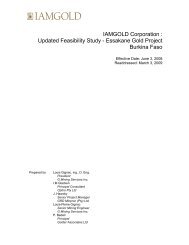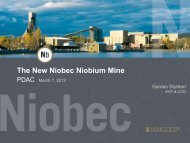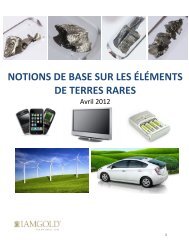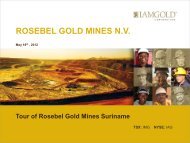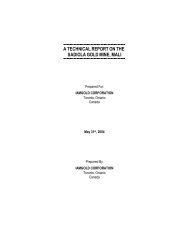NI 43-101 Technical report, Surface diamond drilling ... - Iamgold
NI 43-101 Technical report, Surface diamond drilling ... - Iamgold
NI 43-101 Technical report, Surface diamond drilling ... - Iamgold
Create successful ePaper yourself
Turn your PDF publications into a flip-book with our unique Google optimized e-Paper software.
R a r e E a r t h E l e m e n t E x p l o r a t i o n P r o g r a m M a r c h - 2 0 1 3<br />
W i n t e r - S u m m e r 2 0 1 2 P a g e | 25<br />
9.2.1.4.4 Conclusion of the petro-mineralogical study of REE Zone<br />
Petrographic and mineralogical highlights are based over historical works leaded by Fortin<br />
(1977), Gauthier (1979) and Fournier (1993). Additional <strong>drilling</strong> of the REE Zone has been<br />
realized recently (2011 and 2012) by IAMGOLD-Niobec. Thus 61 drill holes, totaling<br />
37,649 m of new data, confirmed and update, particularly at depth, the previous observations.<br />
In 2012, IAMGOLD and UQAC (Université du Québec à Chicoutimi) collaborated in a new<br />
petrographic, mineralogical and geochemical study. A master project, realised by Alexandre<br />
Neron, Geo. Stag. and supervised by Paul Bédard, Ing. Ph.D. will focus on the REE zone and<br />
the new <strong>drilling</strong> datas.<br />
The observation, at a macroscopic scale, of some of the core of these recent drill holes<br />
confirm all the macroscopic petrographic data mentioned above with additional and<br />
complementary information, thus:<br />
• These breccia correspond to hydrothermal breccia related to igneous activity, attested<br />
by the multiple hydraulic breccia structures;<br />
• Presence of multiple breccia phases (brecciation of breccia);<br />
• The REE zone is constituted by mainly ferrodolomitite breccia with the presence<br />
locally of, a mineralized or not, calcitite breccia facies;<br />
• The breccia zone shows the existence of numerous clasts of syenite highly altered<br />
corresponding probably to xenoliths;<br />
• Presence of at least two mineralized phases expressed by the presence of lanthanides<br />
in the carbonates elements of the breccia (impregnation) and mainly in the matrix of<br />
this breccia;<br />
• Presence of at least a mineralized alteration front affecting all the core breccia<br />
(dolomitic and calcitic) testified by the existence of small barren zones of the different<br />
brecciated facies or small patches of different sizes in the mineralized zones.<br />
These observations confirm the existence of multiple stages of igneous activity and a<br />
metasomatic replacement characteristic of the carbonatite complexes.<br />
Based on petrographic observations, the paragenesis of REE Zone can be subdivided into<br />
four stages (Fournier, 1993):<br />
• The first consisted of the crystallization of a dolomite low in Nb and REE (C2),<br />
• This was followed by brecciation (C1) and deposition of synchisite and possibly<br />
parisite, monazite and thorite. Ankerite, ferroan dolomite, hematite and chlorite were<br />
also introduced in this stage,<br />
• The next stage consisted of the formation of veinlets of barite, fluorite and calcite,<br />
• The last event was the meteoric alteration which caused hematization.<br />
This model is in accordance with the chronology of the whole carbonatite complex buildup,<br />
advanced by Fortin in 1977:<br />
3400, chemin du Columbium, St-Honoré-de-Chicoutimi, QC G0V 1L0 Canada – tel. : 418 673-4694 Fax : 418 673-3179<br />
E-mail : info.niobec@iamgold.com www.niobec.com





